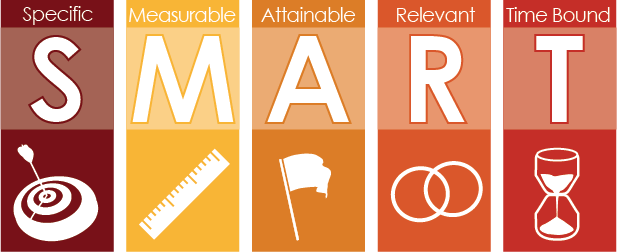12

Now that you have evaluated where you are in your learning journey, you can begin to set goals for the semester ahead. One common tool for effective goal setting is developing SMART goals. These goals are:
Specific: Your goal will clearly define what you are going to accomplish. You will ask and answer the What and Why of your goal.
Measurable: You will identify criteria for measuring progress toward the attainment of each goal you set. This will be the definition of How you will attain your goal.
- How will you know when the result that you want has been achieved?
- How will you verify your achievement/performance of this goal?
Attainable: Is it possible for you to achieve your desired goal? Can you see a path to your accomplishment? You are the Who in this goal setting process. It is your positive attitude that will allow you to draw on your current strengths and develop new ones as you meet your goal.
Relevant: Realistic goals must represent an objective toward which you are willing to work and which are relevant to you. You need to identify Where this goal will take you. A goal can be both high and realistic; you are the only one who can decide just how high your goal should be. Just be sure that each of your goals represents substantial progress.
Time Bound: You need to create a sense of personal urgency by setting times for each step along the way. Knowing When you have to accomplish a task keeps to on track and accountable. What needs to be done by when? Be timely! [1][2]
Consider an example. I could say that my goal is to become a better runner. This goal is undefined, and I will not be able to tell if I have achieved it. A SMART goal would be, “I will complete a ten kilometre run in under one hour by the end of June after training with my running group twice weekly”. Note that this goal is time-bound, and includes specific and measurable criteria that help me to know if I have successfully achieved it.
Try it!
Begin to set your learning goals for this semester. Choose one goal, and use the SMART goal system to check that your goal is relevant and achievable. Click here to download a printable worksheet for this activity.
| Specific
|
|
| Measurable
|
|
| Attainable
|
|
| Relevant
|
|
| Time-bound
|
Extend Your Learning
Goal setting can be challenging, but clearly identifying where you want to go on your learning journey and how you intend to get there will help you in the long run.
- Learn more about the importance of goals and continue your practice of goals setting by using this SMART goals template
Licenses and Attributions:
Content previously published in University 101: Study, Strategize and Succeed by Kwantlen Polytechnic University, licensed as CC BY-SA.
